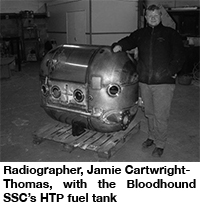Bloodhound SSC’s fuel tank undergoes non-destructive testing
10/08/2015
In 2016, the Bloodhound SuperSonic Car (SSC) will attempt to match or exceed 1000 mph in order to achieve a new land-speed record. Before the record is attempted, a number of test-firings will take place in the UK using the high-test peroxide (HTP) fuel tank designed and manufactured by ABC Stainless Ltd, a Peterborough-based fabrication company. A vessel such at this, designed with pressure-containing welds on the exterior, must be tested for defects prior to use; a crucial step in ensuring the integrity of the tank before it is put under any pressure.
During the production process of the category 1 PD5500 316 stainless steel pressure vessel, which is designed to hold 1000 litres of fuel, a family-run and Suffolk-based non-destructive testing (NDT) company, Gammax Independent Inspection Services Limited (GIIS), carried out a series of highly-sensitive and accurate tests to detect porosity, inclusions, cracks and leaks in the welds, to ensure that the HTP fuel tank was sound.
The NDT methods used by GIIS to test for internal and surface-breaking defects were 100% radiographic (RT) and 100% liquid penetrant inspection (LPI). When fully constructed, the tank is circular on the ends with four domed quadrants, with a wall thickness of 2 mm. Once the correct sensitivity for that level of thickness was determined by GIIS and before the tank was sealed, the first stage of testing (around 80% of the total testing process) was carried out with the radiographic film placed inside the tank, enabling the use of a single-wall exposure/single-image arrangement (SWE/SI).
However, to ensure that the second stage of testing was carried out fully and effectively, the tank had to be in its complete sealed state. With the last quadrant welded into place the tank was fully sealed, which made it impossible to carry out the RT in the same way as with the previous three quadrants. Therefore, in order to carry out what was now the most demanding part of the inspection, GIIS had to use a double-wall exposure/single-image (DWE/SI) arrangement from the outside of the vessel. Obtaining results with this type of arrangement typically takes more time due to the X-ray head having to penetrate double the wall-thickness than in the previous tests, with further to travel to reach the radiographic film on the opposite side of the vessel, around 1 m in distance.
William Brennan, Managing Director of GIIS, said: “In the event that the fuel tank had not undergone these tests, the results of failure could have been catastrophic should there have been undetected defects.” Although the NDT took over a week to complete, it was undeniably crucial in guaranteeing the safety and integrity of the HTP tank prior to the test-firings taking place in the UK.
The Bloodhound SSC Show Car will be making a special guest appearance at the Materials Testing Exhibition in Telford from 8-10 September 2015. In the meantime, see NDT News for news and updates on the progress of the Bloodhound SSC project and the role that NDT plays in ensuring its safety.